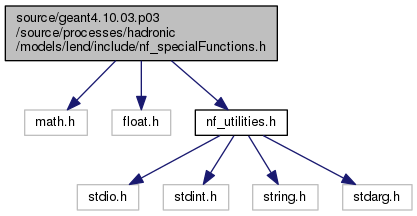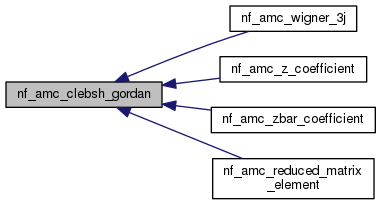|
Geant4
10.03.p03
|
|
Geant4
10.03.p03
|


Go to the source code of this file.
Functions | |
| double | nf_polevl (double x, double coef[], int N) |
| double | nf_p1evl (double x, double coef[], int N) |
| double | nf_exponentialIntegral (int n, double x, nfu_status *status) |
| double | nf_gammaFunction (double x, nfu_status *status) |
| double | nf_logGammaFunction (double x, nfu_status *status) |
| double | nf_incompleteGammaFunction (double a, double x, nfu_status *status) |
| double | nf_incompleteGammaFunctionComplementary (double a, double x, nfu_status *status) |
| double | nf_amc_log_factorial (int) |
| double | nf_amc_factorial (int) |
| double | nf_amc_wigner_3j (int, int, int, int, int, int) |
| double | nf_amc_wigner_6j (int, int, int, int, int, int) |
| double | nf_amc_wigner_9j (int, int, int, int, int, int, int, int, int) |
| double | nf_amc_racah (int, int, int, int, int, int) |
| double | nf_amc_clebsh_gordan (int, int, int, int, int) |
| double | nf_amc_z_coefficient (int, int, int, int, int, int) |
| double | nf_amc_zbar_coefficient (int, int, int, int, int, int) |
| double | nf_amc_reduced_matrix_element (int, int, int, int, int, int, int) |
Definition at line 288 of file nf_angularMomentumCoupling.cc.


| double nf_amc_factorial | ( | int | ) |
Definition at line 96 of file nf_angularMomentumCoupling.cc.

| double nf_amc_log_factorial | ( | int | ) |
Definition at line 85 of file nf_angularMomentumCoupling.cc.

Definition at line 253 of file nf_angularMomentumCoupling.cc.


Definition at line 473 of file nf_angularMomentumCoupling.cc.

Definition at line 105 of file nf_angularMomentumCoupling.cc.

Definition at line 121 of file nf_angularMomentumCoupling.cc.


Definition at line 226 of file nf_angularMomentumCoupling.cc.

Definition at line 437 of file nf_angularMomentumCoupling.cc.

Definition at line 453 of file nf_angularMomentumCoupling.cc.

| double nf_exponentialIntegral | ( | int | n, |
| double | x, | ||
| nfu_status * | status | ||
| ) |
Definition at line 28 of file nf_exponentialIntegral.cc.


| double nf_gammaFunction | ( | double | x, |
| nfu_status * | status | ||
| ) |
Definition at line 126 of file nf_gammaFunctions.cc.


| double nf_incompleteGammaFunction | ( | double | a, |
| double | x, | ||
| nfu_status * | status | ||
| ) |
Definition at line 155 of file nf_incompleteGammaFunctions.cc.


| double nf_incompleteGammaFunctionComplementary | ( | double | a, |
| double | x, | ||
| nfu_status * | status | ||
| ) |
Definition at line 88 of file nf_incompleteGammaFunctions.cc.


| double nf_logGammaFunction | ( | double | x, |
| nfu_status * | status | ||
| ) |
Definition at line 206 of file nf_gammaFunctions.cc.

| double nf_p1evl | ( | double | x, |
| double | coef[], | ||
| int | N | ||
| ) |
| double nf_polevl | ( | double | x, |
| double | coef[], | ||
| int | N | ||
| ) |